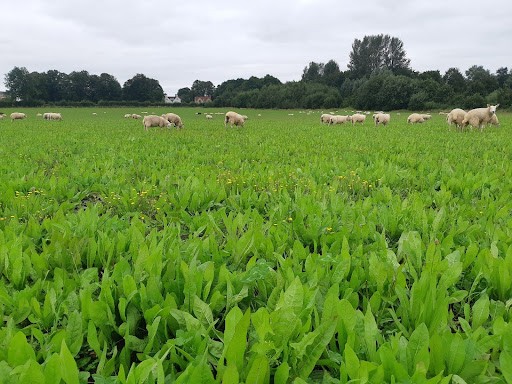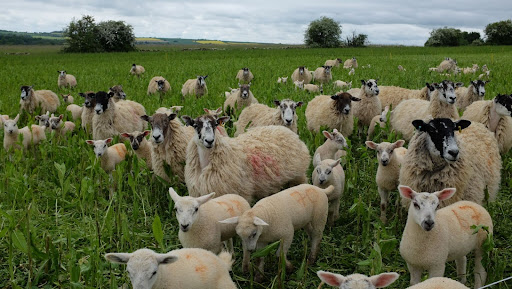This feature written by Sam Lane, Director of Seeds & Tehcnical, appeared in the August/September 2024 issue of 'Sheep Farmer' Magazine
Planning for optimum performance of lambs post weaning is vital for reducing stress and maximising liveweight gains. Generally, weaning is carried out between 10-12 weeks of age, however there are important points to consider; from 8 weeks of age, lamb’s efficiency at converting energy from grass is greater than from milk. If forage availability/quality is low, competition will arise between lambs and ewes for forage. Ewes still require enough forage to maintain body condition for tupping, therefore if DM yields are low (If lamb DLWG falls below 200g/day), it would be beneficial to wean lambs earlier onto a high-quality forage. Multi-species leys have shown multiple benefits for weaned lambs, including increased DLWG, reduced anthelmintic usage and reaching slaughter weight faster.

Nitrogen fixing species such as white clover, in a mix with ryegrass can achieve comparably higher lamb performance; trials have shown an increase in the rate of DLWG from weaning to slaughter by 25%, with heavier carcass weights. White clover is a highly beneficial component of mixed leys; it fixes 150 kg N/ha, is highly palatable (D-value of 75-82), high in protein (25% CP) and a rich source of minerals. Smaller leaved varieties of white clover are more suitable under sheep grazing, as they have a low creeping growth habit, and withstand hard, continuous grazing.
Alternatively red clover and ryegrass produces multiple high quality, high protein silage cuts through the summer, and is ideal for aftermath grazing lambs into the autumn, reaching slaughter weight early to achieve favourable market prices. Although management is key; red clover grows from a crown therefore overgrazing risks permanently damaging the ley. It is also important to note that red clover contains phytoestrogens which may have a negative effect on the fertility of breeding ewes. Do not graze six weeks either side of tupping to reduce the risk.
Lucerne (alfalfa) is a good option for those on lighter, free draining, neutral soils. It has a very deep taproot for accessing moisture, whilst also fixing up to 150kg N/ha . Pair with grass to provide a high yielding silage cut, with aftermath grazing for finishing lambs from Late August to Mid-winter.

Due to the peri-parturient relaxation in immunity, ewes shedding worm eggs create a heavily contaminated paddock for the first 8-10 weeks of a lamb's life. Lambs do not reach an adult level of innate antibody response until 7-8 months, therefore are increasingly exposed to harmful worm burdens as grass intake surpasses milk. Including chicory, birdsfoot trefoil or sainfoin in the diet provides natural anthelmintic benefits. They contain condensed tannins and phytochemicals which reduce the growth and hatching of helminths, delaying the onset of infection and the transmission between stock. Chicory also effectively reduces the migration and intake of hatched larvae; its large leaves form a canopy whose microclimate critically affects larval development, and the surface is covered in bristles which prevent migration up the plant.
Inclusion of anthelmintic forage in lamb diets can reduce FEC by nearly 50%, reducing the need for anthelmintic treatments. Tannins also have beneficial effects on digestion, they bind to protein to prevent degradation in the rumen, increasing its availability for absorption in the small intestine for improved growth performance and meat, milk and wool production.
Tannins also significantly suppresses the incidence of rumen bloat. They form tannin-protein complexes which resist degradation by rumen microorganisms, reducing the production of rumen gases and frothy bloat. The proteins enter the abomasum to be broken down effectively, releasing proteins as utilisable amino acids.

Herbs such as chicory, ribgrass (plantain) and sheeps parsley are highly beneficial in drought tolerant pastures, their deep roots can access more moisture to provide ample forage throughout the summer, whilst also mining minerals such as selenium, iron and copper (essential for red blood cell formation and preventing swayback), cobalt and iodine (preventing anaemia and pine), and vitamins A and C (associated with growth and maintenance of bone/body tissues). Ribgrass (plantain) is also high in protein and calcium (over four times higher than perennial ryegrass), comparable to white clover. It is highly palatable, research has shown that livestock will selectively graze it out of swards so is best suited to strip grazing.
Through Darwin’s ‘Over-yielding’ theory, increasing the biodiversity of plant species within a sward increases the overall DM yield through differing rooting depths, stem elongation and nutritional requirements. Subsequently, lambs are able graze the multispecies ley at a higher stocking rate. Mob-grazing lambs, where they are moved onto fresh forage everyday (and back fenced) makes best utilisation of multi-species leys, and are beneficial for providing clean, worm free pasture. Introduce lambs onto the next break when they are full to avoid overindulgence on the new crop.
Research has shown that species rich leys also improve the diversity of decomposer organisms and mycorrhizal fungi associations, protecting the plants from soil borne pathogens and competition.
Growth rates following weaning is a direct response to feed intake, quality and the ability of the rumen to process the forage. The transition period onto multi-species leys (especially herbal leys) is critical for reducing weaning stress and bloat from overindulgence of richer forage. It should take approximately 3 weeks for the rumen to adapt, research has shown that introducing lambs to multi-species leys whilst still with their mothers promotes higher voluntary intake once weaned, allows for a period of rumen development prior to weaning, and reduces stress where the lambs are familiar with the paddock. Ensure lambs are offered supplementary fibre; grass field margins, access to adjacent fields or hay can help regulate intake of clover-rich pasture and prevent red gut.
{Image4}
Herbal Ley Mixture